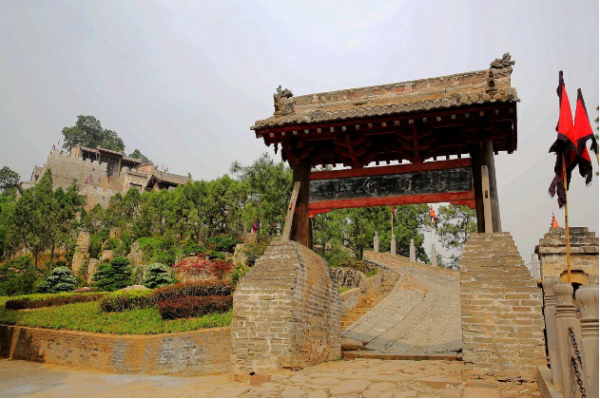Shiji—a Renowned Historic Record
China attaches special attention to its tradition and civilization, which makes history, the records of traditions and events, enjoy significant position among all disciplines. National unification in its real sense was not realized until the Qin Dynasty, which makes it impossible for one single historic book to cover all the past events in China. This great task was not fulfilled until the Western Han Dynasty when the country was unified in its real sense. The famous historian who completed this task was none other than Sima Qian, a Shaanxi native during the reign of Emperor Wudi of Han.
Sima Qian was born in Xiayang, Zuoyi Region (in recent Hancheng County) in the Western Han Dynasty. With a good family education during his childhood and influenced by his historian father Sima Tan, Sima Qian took a preference over history. After his father died, he succeeded his father as an official historian. In the national library, he gained access to a large number of history books. After traveling to various places in China, he participated in the compilation of Taichuli, the first complete calendar, which facilitated his historic record book, the first such work in Chinese history. But, just as he was prepared to start his scholastic career, he was castrated by Emperor Wudi as a punishment for his defense for General Li Ling’s military failure and surrender to the enemy. With severe physical suffering and the burning shame, Sima Qian followed examples of such self-disciplined historic figures as King Wenwang of Zhou, Confucius, Zuo Qiuming and Qu Yuan and dedicated his lifetime to writing the historic record Shiji until his death.
Consisting of 130 articles of about 520,000 characters in total, Shiji is the first historic record presented in a series of biographies. In the book, there are historic stories in about 3,000 years since the legends about the Yellow Emperor to the anecdotes about Emperor Wudi of Han. In Shiji, Sima Qian proposed for the first time that the Yellow Emperor was the common ancestor of the Chinese people, which served as a spiritual affinity for the unification of the Chinese people at that time.

A photocopy of Shiji
Shiji comprises articles of five genres including the biographic sketches of emperors, memorials to the emperors, official documents, biographies of the dukes or princes and biographies of common figures, which regulated the basic format of official historic records for the following dynasties. As the first historic record to present the Chinese history from a world perspective, Shiji expanded the coverage for the first time to areas outside of the hinterland of China including the recent Tibet, Vietnam, Southeastern Asia, and the Central Asia. The new perspective greatly broadened the horizon of people at that time.
Shiji is an encyclopedia of economy, politics, military affairs, nationalities, ideology, culture, society and biographies of figures of various social status of ancient China. But the significance of it lies most in its detailed description about the history before the Western Han Dynasty and the lessons that can be drawn from the history of Qin and Han dynasties in particular, which is best illustrated by the traditional valuation of “studying the relationship between nature and human beings and analyzing the ups and downs in Chinese history”. Examining the reasons for the rise and fall of dynasties in Chinese history through analyzing the relations between nature and human beings is not only the final objective of Sima Qian in writing Shiji, but also the essence of his historic philosophy. Moreover, it was also keenly followed by historians, thinkers and philosophers for generations as a common creed and basic principle in academic research.

Holistic view of Sima Qian tomb and temple
Scholars in the following dynasties highly praised his renowned works Shiji from various perspectives and such titles as the Holy Historic Record, an Encyclopedia of Chinese History, the Gem of the Chinese Culture and Civilization and the Acme in Chinese Historic Books are all well-deserved honors for it. We can safely claim that Sima Qian and his renowned Shiji rooted in Shaanxi Province marked the greatest contribution to the people for Chinese civilization. For some scholars, however, Sima Qian is a figure in Western China who made equal contribution to Chinese civilization with Confucius in Eastern China. These two academic stars in Chinese history will shed forever their splendid light in the entire expanse of the sky of Chinese civilization.
After Sima Qian died, he was buried on a hillock, which enjoys an overlook of the Yellow River to the east and takes the Liangshan Mountain as a backdrop in the west. To the south is a deep gully in which there are ancient paths for horses and carriages. The entire location enjoys quite a majestic view and in the Western Jin Period (310AD) a temple was erected around the tomb which was later frequented by visitors and worshippers and was shrouded in incense smokes for generations.With continual repairs during the following dynasties, it gradually became a construction complex with tombs and temples. Although rulers of various dynasties held a special passion against Sima Qian, he won a high position in common people’s heart and therefore his tomb and temple was regarded by ordinary people as a sacred place. Recently, the temple has become the State-level Cultural Heritage Protection Unit in China.
Dozens of years after Sima Qian, another renowned historian named Ban Gu was born in Shaanxi. Ban Gu wrote the first dynasty—specific bibliographic historic record, Hanshu, which was the second important historic works completed in China. It was later regarded as the model for dynastic record and had therefore great significance in Chinese historic studies. This book was also written by a Shaanxi historian, which once again testified the contribution of Shaanxi to the entire Chinese civilization.


